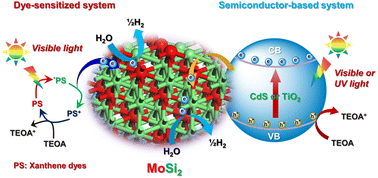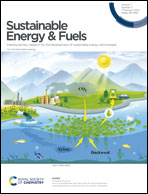Intermetallic molybdenum disilicide: a new, active, and stable cocatalyst for efficient solar hydrogen production†
Abstract
The exploration of active, durable, and cost-efficient cocatalysts is pivotal for developing effective photocatalysts/systems for sustainable photocatalytic H2 production from water splitting. Herein, we report intermetallic molybdenum disilicide (MoSi2) as a novel, active, and durable cocatalyst for the photocatalytic H2 evolution reaction (HER) in a dye-sensitized photocatalytic system and on semiconductor photocatalysts. Density functional theory (DFT) calculations suggest that the Mo sites are the main active sites with a near-zero Gibbs free energy of hydrogen adsorption (ΔGH = 0.02 eV), thus endowing MoSi2 with favorable H2 evolution kinetics and a lower overpotential. When sensitized with organic xanthene dyes, e.g., Erythrosin B (ErB), MoSi2 can efficiently catalyze the photocatalytic HER with high activity and excellent cycling stability, and outperforms other Mo-based cocatalysts and transition metal disilicides. Furthermore, MoSi2 also serves as an efficient and stable cocatalyst on inorganic semiconductor photocatalysts, such as CdS and TiO2. This work demonstrates the great potential of transition metal silicides as efficient and low-cost H2 evolution cocatalysts for constructing high-performance photocatalysts/systems for solar energy conversion.



 Please wait while we load your content...
Please wait while we load your content...